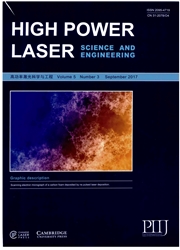

 中文摘要:
中文摘要:
The driving mechanism of solar flares and coronal mass ejections is a topic of ongoing debate, apart from the consensus that magnetic reconnection plays a key role during the impulsive process. While present solar research mostly depends on observations and theoretical models, laboratory experiments based on high-energy density facilities provide the third method for quantitatively comparing astrophysical observations and models with data achieved in experimental settings.In this article, we show laboratory modeling of solar flares and coronal mass ejections by constructing the magnetic reconnection system with two mutually approaching laser-produced plasmas circumfused of self-generated megagauss magnetic fields. Due to the Euler similarity between the laboratory and solar plasma systems, the present experiments demonstrate the morphological reproduction of flares and coronal mass ejections in solar observations in a scaled sense,and confirm the theory and model predictions about the current-sheet-born anomalous plasmoid as the initial stage of coronal mass ejections, and the behavior of moving-away plasmoid stretching the primary reconnected field lines into a secondary current sheet conjoined with two bright ridges identified as solar flares.
 同期刊论文项目
同期刊论文项目
 同项目期刊论文
同项目期刊论文
 Off-focus generation of strong super-continuum emission in fused silica using high power femtosecond
Off-focus generation of strong super-continuum emission in fused silica using high power femtosecond Numerical study on coherent keV x ray generation by the interaction of ultra-short intense lasers wi
Numerical study on coherent keV x ray generation by the interaction of ultra-short intense lasers wi Quasibound states in graphene quantum-dot nanostructures generated by concentric potential barrier r
Quasibound states in graphene quantum-dot nanostructures generated by concentric potential barrier r Numerical studies on intense laser-generated relativistic high-energy electrons via a thin cone targ
Numerical studies on intense laser-generated relativistic high-energy electrons via a thin cone targ Wavelength-Versatile Graphene-Gold Film Saturable Absorber Mirror for Ultra-Broadband Mode-Locking o
Wavelength-Versatile Graphene-Gold Film Saturable Absorber Mirror for Ultra-Broadband Mode-Locking o High - field half - cycle terahertz radiation from relativistic laser interaction with thin solid ta
High - field half - cycle terahertz radiation from relativistic laser interaction with thin solid ta Anomalous plasmoid ejection induced secondary magnetic reconnection: modeling solar flares and coron
Anomalous plasmoid ejection induced secondary magnetic reconnection: modeling solar flares and coron Electron transfer mechanism in organometallic molecules studied by subpicosecond extended X-ray abso
Electron transfer mechanism in organometallic molecules studied by subpicosecond extended X-ray abso Quasimonoenergetic collimated electron beams from a laser wakefield acceleration in low density pure
Quasimonoenergetic collimated electron beams from a laser wakefield acceleration in low density pure Control of electron localization in the dissociation of H2+ using attosecond and two-color femtoseco
Control of electron localization in the dissociation of H2+ using attosecond and two-color femtoseco Generation of 120 GW mid-infrared pulses from a widely tunable noncollinear optical parametric ampli
Generation of 120 GW mid-infrared pulses from a widely tunable noncollinear optical parametric ampli Simultaneous investigation of ultrafast structural dynamics and transient electric field by sub-pico
Simultaneous investigation of ultrafast structural dynamics and transient electric field by sub-pico Surface-reflection-initiated pulse-contrast degradation in an optical parametric chirped-pulse ampli
Surface-reflection-initiated pulse-contrast degradation in an optical parametric chirped-pulse ampli Self-truncated ionization injection and consequent monoenergetic electron bunches in laser wakefield
Self-truncated ionization injection and consequent monoenergetic electron bunches in laser wakefield 期刊信息
期刊信息
